The Intel Core i9-9900K at 95W: Fixing The Power for SFF
by Ian Cutress on November 29, 2018 8:00 AM ESTCPU Performance: Office Tests
The Office test suite is designed to focus around more industry standard tests that focus on office workflows, system meetings, some synthetics, but we also bundle compiler performance in with this section. For users that have to evaluate hardware in general, these are usually the benchmarks that most consider.
All of our benchmark results can also be found in our benchmark engine, Bench.
PCMark 10: Industry Standard System Profiler
Futuremark, now known as UL, has developed benchmarks that have become industry standards for around two decades. The latest complete system test suite is PCMark 10, upgrading over PCMark 8 with updated tests and more OpenCL invested into use cases such as video streaming.
PCMark splits its scores into about 14 different areas, including application startup, web, spreadsheets, photo editing, rendering, video conferencing, and physics. We post all of these numbers in our benchmark database, Bench, however the key metric for the review is the overall score.
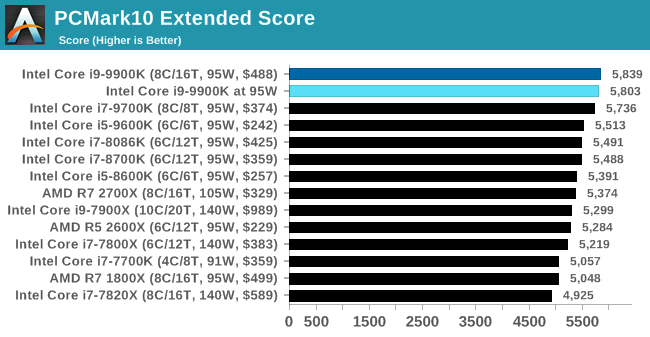
PCMark10 is more forgiving, as it has lots of pauses and only a few full-on power tests, emphasising single core speed. There isn't much lost when in 95W mode here.
Chromium Compile: Windows VC++ Compile of Chrome 56
A large number of AnandTech readers are software engineers, looking at how the hardware they use performs. While compiling a Linux kernel is ‘standard’ for the reviewers who often compile, our test is a little more varied – we are using the windows instructions to compile Chrome, specifically a Chrome 56 build from March 2017, as that was when we built the test. Google quite handily gives instructions on how to compile with Windows, along with a 400k file download for the repo.
In our test, using Google’s instructions, we use the MSVC compiler and ninja developer tools to manage the compile. As you may expect, the benchmark is variably threaded, with a mix of DRAM requirements that benefit from faster caches. Data procured in our test is the time taken for the compile, which we convert into compiles per day.
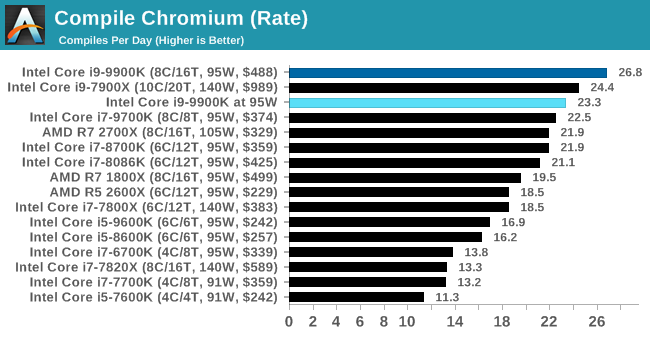
The 95W mode causes a small decrease in performance in our compile test, again moving it within a small margin to the Core i7-9700K.
3DMark Physics: In-Game Physics Compute
Alongside PCMark is 3DMark, Futuremark’s (UL’s) gaming test suite. Each gaming tests consists of one or two GPU heavy scenes, along with a physics test that is indicative of when the test was written and the platform it is aimed at. The main overriding tests, in order of complexity, are Ice Storm, Cloud Gate, Sky Diver, Fire Strike, and Time Spy.
Some of the subtests offer variants, such as Ice Storm Unlimited, which is aimed at mobile platforms with an off-screen rendering, or Fire Strike Ultra which is aimed at high-end 4K systems with lots of the added features turned on. Time Spy also currently has an AVX-512 mode (which we may be using in the future).
For our tests, we report in Bench the results from every physics test, but for the sake of the review we keep it to the most demanding of each scene: Cloud Gate, Sky Diver, Fire Strike Ultra, and Time Spy.
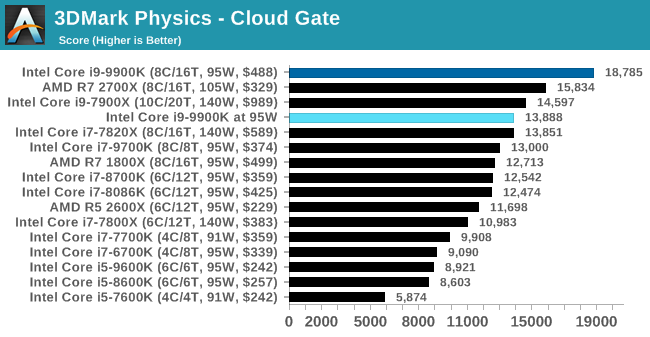


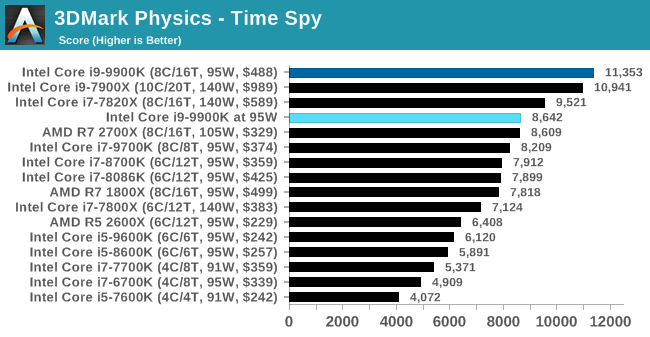
GeekBench4: Synthetics
A common tool for cross-platform testing between mobile, PC, and Mac, GeekBench 4 is an ultimate exercise in synthetic testing across a range of algorithms looking for peak throughput. Tests include encryption, compression, fast Fourier transform, memory operations, n-body physics, matrix operations, histogram manipulation, and HTML parsing.
I’m including this test due to popular demand, although the results do come across as overly synthetic, and a lot of users often put a lot of weight behind the test due to the fact that it is compiled across different platforms (although with different compilers).
We record the main subtest scores (Crypto, Integer, Floating Point, Memory) in our benchmark database, but for the review we post the overall single and multi-threaded results.
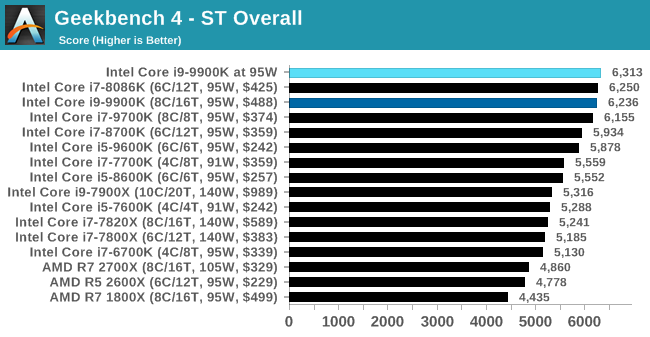











101 Comments
View All Comments
edzieba - Thursday, November 29, 2018 - link
The difference is the ARM chips being labelled with the short-term term frequencies and performance, while Intel put the steady state values on the box. Motherboard manufacturers throw the box values right out the window, but if Intel were to dictate /those/ the wailing and gnashing of teeth from the peanut gallery would be cacaphonous.melgross - Thursday, November 29, 2018 - link
Its just a matter of semantics. It doesn’t have to be spelled out.Targon - Thursday, November 29, 2018 - link
There are actually three primary states. Base clocks, boost or turbo speeds, and then you can get thermal throttle which will actually lower the speed below the base clock speed. If the i9-9900k has a base of 3.6GHz, a turbo that goes up to 5GHz, but you have poor cooling, you may be seeing the CPU sticking to that 3.6GHz, or even below it if the temperatures get too high.This is where those very thin laptops may have Ryzen versions performing better than Intel, because of the temperatures keeping the chip running at or even below base speeds. For a small form factor machine, will the 9900k be running at base speeds ALL THE TIME due to temperatures/TDP/cooling? In the same small form factor case, would a Ryzen 7 2700X end up having a similar level of performance after several hours(to allow the heat generation to stabilize)? If you start when things are COLD, you could turn the machine on and run benchmarks, and see better numbers than if the machine were already on and you had been running intensive applications for several hours prior to running the benchmarks.
eastcoast_pete - Thursday, November 29, 2018 - link
@Ian: Thanks for this informative test and review. One comment, one question/request. Comment: I continue to be struck by Intel's prowess when AVX512/AVX2 comes into play. I am also (negatively) impressed by the thermal load use of these instructions causes. The reduction in performance when using AVX512/AVX2 under strict adherence to a TdP of 95 Wh speaks volumes. Did you ever have a chance to ask Intel why running AVX makes their chips so power-hungry? Even if not, I'd appreciate your thoughts on why AVX makes Intel's chips run so hot.Here my question/request: I now that you/Anandtech have a large dataset on x264 video encoding speeds. However, especially for i7s and AMD's six-core and up Zen chips, I'd like to know how they fare when encoding/transcoding a 2160p 10bit video, as that is now in increasing demand, and really makes the processor sweat (and slow down, a lot). Any chance you and your colleagues can add that to the encoding tests? If space is an issue, I suggest to dump the x264 720p speed test; even a lowly Athlon or Celeron chip does that quite well, and at good speed.
HStewart - Thursday, November 29, 2018 - link
I believe you can turn off AVX512 in bios - it use in special application that need the speedAlso I would think the external GPU's is another major factor in considering power requirements on a system.
I don't belkieve there is any power needs or reduction in topp speed for AVX2 only that AVX512 uses extra power on system and top frequency are reduce if being used.
One thing about AVX2 - on Intel it is 256bit and AMD has dual 128 bits currently - not sure about new Zen's coming out next year. But at least with PowerDirector, it give you significantly performance increase
GreenReaper - Saturday, December 1, 2018 - link
It's pretty simple, really: the more data the CPU has to process in parallel, the more horsepower it uses. It's like doubling or quadrupling the number of active cylinders in an engine - you gain performance, but it requires more power and produces more heat. That's why they're off if not in use.Dedicated GPU blocks for video coding will also use more power, but are likely to be far more efficient than doing the operations with general code - as long as it's within their defined capabilities. (Similarly, if you had to do the equivalent of the AVX operations without the relevant hardware, it would probably use even more power than it currently does, at least over the extra time it took.)
Davenreturns - Thursday, November 29, 2018 - link
I have found much confusion among the readers on hardware review websites when it comes to this issue. So I would like to present some information from Anandtech's Bench tool in order to clarify the situation for me and others hopefully:Looking at the CPU Power Bench
https://www.anandtech.com/bench/CPU-2019/2194
The following two processors have these results under full package, full load:
i7-6700k 82.55W First mainstream desktop 14 nm processor, 95W TDP according to Intel
i9-9900k 168.48W Latest mainstream desktop 14 nm processor, 95W TDP according to Intel
I assume that these two values were measured in unlimited mode. If this is the case, this means that the power listed above is when all cores/threads are loaded at full max turbo mode. So if you are expecting a certain level of performance given that Intel advertises 95W for both CPUs, then you are being misled and may not get the performance you are expecting when upgrading the CPU but not your cooling.
This is a CHANGE from the past in how Intel uses TDP without telling the customer. It also highlights that Intel use to be conservative with cores/clocks/turbo when they had no competition and were able to shrink nodes between Nehalem and Skylake. Now they are PRETENDING that they can just double the cores and raise clocks on the same node and not increase power. Please correct me if I'm wrong, but it doesn't look like this is the case anymore.
AlyxSharkBite - Thursday, November 29, 2018 - link
Really interesting how when you limit it to 95W it’s really close to the 2700X4800z - Thursday, November 29, 2018 - link
A power unlimited 2700x. Also this article doesn't include any games. If it did you'd see the 9900k still does much better, because games don't use all 8 cores.schujj07 - Thursday, November 29, 2018 - link
2700X - 117.18W Max = 11.6% over stated TDP9900K - 168.48W Nax = 77.3% over stated TDP
Don't forget not everyone views gaming and the end all be all form of benchmarking. Would it be interesting to see if it affects the gaming sure. It most certainly would affect those who game and stream at the same time.